
Eriocrania semipurpurella is a moth of the family Eriocraniidae, found from Europe to Japan and in North America. It was first described by James Francis Stephens in 1835. The species closely resembles Eriocrania sangii and the larvae of both species mine the leaves of birch.

Udea is a genus of snout moths in the subfamily Spilomelinae of the family Crambidae. The genus was erected by Achille Guenée in 1845. The currently known 216 species are present on all continents except Antarctica. About 41 species are native to Hawaii.

Anacampsis populella is a moth of the family Gelechiidae, which is native to Europe and has been accidentally introduced to North America. It was first described in 1759 by Carl Alexander Clerck, a Swedish entomologist. The type specimen is from Sweden. The foodplants of the larvae are poplars and willows.

Coleophora ibipennella is a moth of the case-bearer family (Coleophoridae). It was first described by Philipp Christoph Zeller in 1849 and is found in Asia, Europe and North Africa. The larva feed within a pistol case on oak leaves and in the past was confused with Coleophora betulella, whose larva feed from a similar looking pistol case on birch leaves.

Stigmella lapponica is a moth of the family Nepticulidae found in Asia, Europe and North America. It was first described by the German entomologist, Maximilian Ferdinand Wocke in 1862. The larvae mine the leaves of birch.

Phyllonorycter strigulatella is a moth of the family Gracillariidae. It is found in the most of Europe, east to Russia and Japan.
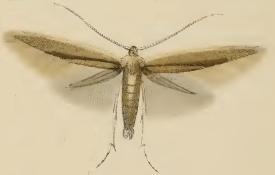
Coleophora milvipennis is a moth of the family Coleophoridae. It is found in all of Europe, east to Japan (Hokkaido).

Anacampsis temerella is a moth of the family Gelechiidae, found in most of Europe, except Belgium, Switzerland, the Iberian Peninsula and the Balkan Peninsula.
Ortholepis vacciniella is a species of snout moth described by Friederike Lienig and Philipp Christoph Zeller in 1847. It is found in Germany, Denmark, Poland, the Baltic region, Russia and Fennoscandia.
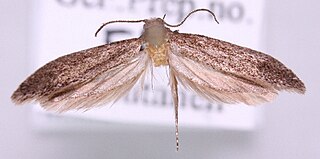
Elatobia fuliginosella is a moth of the family Tineidae. It was described by Friederike Lienig and Philipp Christoph Zeller in 1846. It is found in almost all of Europe, except Ireland, Great Britain, Portugal, the Benelux, Denmark and parts of the Balkan Peninsula, eastwards up to European Russia; in North Africa known from Morocco and Tunisia, eastwards through Siberia up to Mongolia.
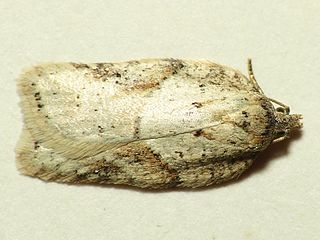
Acleris logiana, the black-headed birch leaffolder moth or grey birch button, is a moth of the family Tortricidae. It was described by Carl Alexander Clerck in 1759. It is found in most of Europe, except Ireland, Portugal, most of the Balkan Peninsula and Ukraine. It is also found in North America, the Russian Far East, Korea and Japan.
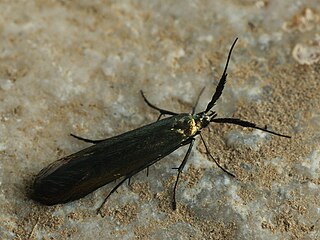
Friederike Lienig was an entomologist from the Russian Empire who also resided in the Kingdom of Prussia. Four species of tiny moths are named after her. One is Cosmopterix lienigiella. At first self taught she was later instructed by Philipp Christoph Zeller at the technical high school in Meseritz. She was a Member of the Stettin Entomological Society.

Atemelia torquatella is a species of moth belonging to the family Plutellidae first described by Friederike Lienig and Philipp Christoph Zeller in 1846.

Epiblema grandaevana is a moth, belonging to the family Tortricidae. The species was first described by Friederike Lienig and Philipp Christoph Zeller in 1846.
Epinotia gimmerthaliana is a moth belonging to the family Tortricidae. The species was first described by Friederike Lienig Philipp Christoph Zeller in 1846.
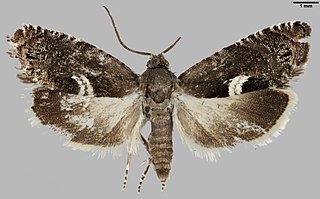
Cydia leguminana is a moth belonging to the family Tortricidae. The species was first described by Friederike Lienig and Philipp Christoph Zeller in 1846.

Pammene ochsenheimeriana is a moth belonging to the family Tortricidae. The species was first described by Friederike Lienig and Philipp Christoph Zeller in 1846.
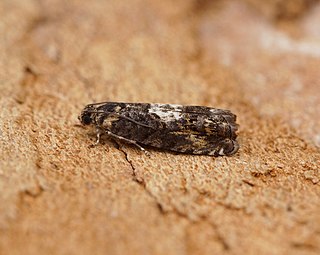
Pammene suspectana is a moth belonging to the family Tortricidae. The species was first described by Friederike Lienig and Philipp Christoph Zeller in 1846.












